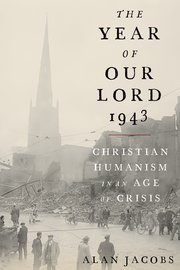 Alan Jacobs’s new book, The Year of Our Lord 1943: Christian Humanism in an Age of Crisis, traces a fascinating intellectual debate that arose on the Western home front during World War II. The five figures his narrative follows—Jacques Maritain, T. S. Eliot, C. S. Lewis, W. H. Auden, and Simone Weil—were worried that the Allies might overcome the technological power of the Nazis and fascists, yet fail to sustain a credible cultural alternative. To put it another way, they were concerned that the Allies might win the war but lose a humane civilization. And as they articulated a vision of Christian humanism that might undergird such a civilization, they emphasized the need for a moral education, one that forms affections and virtues rather than merely imparting technical skill.
Alan Jacobs’s new book, The Year of Our Lord 1943: Christian Humanism in an Age of Crisis, traces a fascinating intellectual debate that arose on the Western home front during World War II. The five figures his narrative follows—Jacques Maritain, T. S. Eliot, C. S. Lewis, W. H. Auden, and Simone Weil—were worried that the Allies might overcome the technological power of the Nazis and fascists, yet fail to sustain a credible cultural alternative. To put it another way, they were concerned that the Allies might win the war but lose a humane civilization. And as they articulated a vision of Christian humanism that might undergird such a civilization, they emphasized the need for a moral education, one that forms affections and virtues rather than merely imparting technical skill.
As my brief summary indicates, Jacobs’s project includes elements of both history and argument; he’s narrating a particular intellectual history, and he’s defending the wisdom these figures provide. For the most part, these dual purposes are compatible, but at times I found myself wanting more synthesis and analysis. Much of the book is content to interweave the thinking of his five protagonists without teasing apart the inherent tensions among them or mustering an argument about which view Jacobs thinks is best. He compares his narrative mode to the cinematic method of Orson Welles, and I appreciate the challenges of crafting a unified story from the lives of five individuals who rarely, if ever, interacted directly with each other. Nevertheless, I kept wishing Jacobs was more explicit regarding his own evaluation of their ideas. In what follows, then, I focus on the sometimes implicit argumentative thread that runs through Jacobs’s narrative, paying particular attention to how this remarkable group of people might offer us wisdom regarding the challenges of our own time.
Moral Foundations
The rise of fascists and Nazis raised acute questions regarding the sufficiency of pragmatist ethics. In the 1930s, many Western observers worried that their civilization didn’t have the resources to stand up to these growing threats. As Robert Hutchins, president of the University of Chicago, warned, “neither positivism nor pragmatism can explain why democracy is superior to totalitarianism” (16). Hutchins was not alone. As Jacobs demonstrates, there was “widespread concern . . . that liberal instrumentalism, that willingness to defer ultimate questions as the price to be paid for getting along with one another, had left the democratic West unable to generate the energetic commitment necessary to resist the military and moral drive of societies that had clear answers to Quid sit homo?” (33-34).
While such concerns were discussed by a broad range of people, it may be helpful to group the conversation into three main groups: Christian humanists, committed liberals, and Niebuhrian Christian realists. Jacobs’s five protagonists belong to the first group. While they differ regarding how to define Christian humanism, they all agree that “they are living in ‘the age of the crisis of Man,’ and that that crisis can only be resolved by the restoration of the specifically Christian understanding of the human being. . . . And they also share the conviction that this restoration will not be accomplished only, or even primarily, through theology as such, but also and more effectively through philosophy, literature, and the arts” (50). These humanist pursuits, they believed, were essential to the task of moral education.
Of course, not all were on board with such a project. John Dewey is Jacobs’s chief representative of the committed liberal group, and unsurprisingly, he wasn’t convinced that pragmatism and rational positivism should be discarded. He worried that attempts to recover a firmer moral ground for education would “end dialogue and impose, by authoritarian administrative diktat, a single understanding of the world” (18). We cannot return to some prior era of ideological unity, and Dewey argues that students needed to be educated for the contemporary secular, pluralist world. Left unanswered by Dewey was the crucial question of whether such a liberal, technocratic order can provide people with sufficient meaning and significance. If not, blood and soil nationalism or one of its variants promised to fill this void. And as the recrudescence of racialized nationalism indicates, this remains a pressing question for today’s liberals: from ISIS to the alt-right, there remain plenty of compelling narratives that promise to give individuals lives of meaning and purpose. Bloodless technocracy struggles to compete with such narratives.
Reinhold Niebuhr is the spokesman for the final group. Rather than settle for the slow work of moral formation, he emphasized the need for Christians to get their hands dirty in political struggles so as to gain power and effect real change. He challenged Christians to “plunge into the give-and-take of ‘power politics’ with the hope of getting something useful done,” believing that “a ‘technical age’ … must be confronted on its own terms, not avoided by a shift sideways into an essentially private realm of personal formation” (52-53). While it would certainly be unfair to lump Niebuhr with today’s “court evangelicals,” both come uncomfortably close to the machinations of realpolitik in their pursuit of temporal goods.
Humans are eternal and political civilizations are not.
In discussing Auden’s review of Niebuhr’s Christianity and Power Politics, Jacobs summarizes Auden’s subtle critique in the form of a pointed question: “What would it profit the church to engage effectively in ‘power politics’ but lose its own soul through neglecting the witness, and the proper formation, of its saints?” (55). Or, as Lewis wrote a year later, “‘How if civilization has been imperiled precisely by the fact that we have all made civilization our summum bonum? Perhaps it can’t be preserved in that way. Perhaps civilization will never be safe until we care for something else more than we care for it’” (56). In other words, Jacobs’s Christian humanists worried that Niebuhr’s realism acquiesced too easily to the technocratic paradigm, one which all too often treats individual humans as means to achieve lofty goals. By doing so, such regimes forget that humans are eternal and political civilizations are not.
Demonic Force
To pursue Christian ends by Christian means, then, requires a rejection of technocratic force, which is inherently demonic. These are strong terms, but they reflect the remarkable interest that Jacobs’s protagonists showed in the principalities and powers of this world. According to these thinkers, the world is enchanted, and demonic powers are at work even in—and perhaps especially in—a technocratic society.
Poetry, narrative, and satire might clarify our imaginations, enabling us to see the demonic powers and principalities behind technocracy. Jacobs quotes Lewis on this matter: “‘Spells are used for breaking enchantments as well as for inducing them. And you and I have need of the strongest spell that can be found to wake us from the evil enchantment of worldliness which has laid upon us for nearly a hundred years’” (78). Charles Williams, a friend of several of Jacobs’s quintet, wrote numerous novels with this aim, and Lewis’s The Screwtape Letters uses satire to awaken readers’ imaginations to the reality of demonic forces.
Auden’s great Christmas poem For the Time Being seeks to unmask these spiritual battle lines by portraying Herod as a good liberal technocrat, one who recognizes the grave threat to his order that the birth of Christ poses. As Jacobs explains,
What Herod realizes is that this Child and the message he brings of universal forgiveness and reconciliation with God do not offer a rival source of power and order but a radical alternative to what the classical world understands as “power” and “order.” They do not seek to replace him on the throne of his kingdom but to usher in a wholly new Kingdom, not providing “spiritual benzedrine for the earthly city” but replacing that city with a new one: the City of Man passes away, the City of God abides forever. This Child marks the end of the machine, the end of the military-industrial complex, the end of force.
Yet the Christian Church has not always recognized this disjuncture as clearly as Auden’s Herod does. Too often, it has arrogated worldly power to impose a purportedly “Christian” order. Weil, in fact, claimed that the Gothic Middle Ages were deeply marred by the Church’s improper use of force, and she pointed to the Romanesque period as a more healthy example of Christian witness. When the Gothic French kings chose to stamp out the Cathars by force, they “‘made an evil choice’” (99). For Weil, Christians should respond to error by faithful witness rather than coercive correction (David Bentley Hart would agree).
Eliot’s “way of ignorance” is a radical refusal of the demonic temptations of force.
Eliot’s “East Coker” portrays a similar view of Christian fidelity. Rather than insisting on finding any means possible to achieve our ends, Eliot recommends faithful, virtuous living: “For us, there is only the trying. The rest is not our business.” I am reminded here of Wendell Berry’s adage that “hope lives in the means, not the end.” And in fact, the title of one of Berry’s books, The Way of Ignorance comes from Eliot’s “East Coker.” Eliot’s “way of ignorance” is a radical refusal of the demonic temptations of force. When Christians succumb to this temptation, they lose the war even if they happen to win a battle.
Education
Given their theological commitments—a belief in the eternal value of human beings and the evil of technological regimes that instrumentalize humans—it makes sense that these Christian humanists would turn their attention to forms of education that might liberate humans from technocracy and enable them to more fully participate in the divine life of love.
It was Maritain who spelled all this out with the greatest philosophical rigor. In his Terry Lectures, given in 1943, he argued on the basis of “personalism” for this mode of education: “‘the prime goal of education is the conquest of internal and spiritual freedom to be achieved by the individual person, or, in other words, his liberation through knowledge and wisdom, good will, and love’” (126). Maritain warned that in Europe, the great danger “was a false and ultimately poisonous model of group identity” and that “in America, the chief impediment to genuine education was technocratic pragmatism” (129). Both violated the true nature of the human person.
Lewis outlined a similar theological anthropology in “The Weight of Glory,” and in books like The Abolition of Man and That Hideous Strength he showed how technocracy so easily becomes demonic because it treats people as disposable instruments and answers to no binding moral law. Education, then, should not merely aim to train workers in particular skills, but to form immortal souls in what Augustine calls the ordo amoris. Students must be taught what and how to love created goods, and “one of the primary objects of pedagogical attention, especially in a child’s early years, will be the training of such responses” (137). Such an educational vision “stood . . . against the commanding power of the nation-state, against pragmatism, against modern technocratic canons of efficiency” (148).
 Weil defended a similar vision, arguing in The Need for Roots “for an education that trains the sensibility and affections at least as seriously as it attends to the mind: ‘To show what is beneficial, what is obligitory, what is good—that is the task of education. Education concerns itself with the motives for effective action’” (164). And as Weil saw clearly, technocracy threatens such an education with its focus on simply improving means. Technocracy must be fought by striving to “keep ‘continually in mind a clear and absolutely precise conception of the particular ends to which this, that or the other technique should be subordinated’” (165).
Weil defended a similar vision, arguing in The Need for Roots “for an education that trains the sensibility and affections at least as seriously as it attends to the mind: ‘To show what is beneficial, what is obligitory, what is good—that is the task of education. Education concerns itself with the motives for effective action’” (164). And as Weil saw clearly, technocracy threatens such an education with its focus on simply improving means. Technocracy must be fought by striving to “keep ‘continually in mind a clear and absolutely precise conception of the particular ends to which this, that or the other technique should be subordinated’” (165).
As Weil perceives, technocracy can only be tamed if a culture maintains a “precise conception of the particular ends” that various technologies should serve. Otherwise, the allure of fascinating technical means ends up determining our ends. Elsewhere, Jacobs terms this tendency the Oppenheimer Principle, best summed by the atomic physicist Robert Oppenheimer who stated, “When you see something that is technically sweet, you go ahead and do it and argue about what to do about it only after you’ve had your technical success. That is the way it was with the atomic bomb.” This principle, of course, also operates in more banal contexts: If I can watch videos on my phone, I might as well do so. (Incidentally, this is why I think Andy Crouch’s The Tech-Wise Family is so good—he begins by defining their family’s goals and then seeks to discern which technologies and practices will best serve these goals.)
Despite this high view of education’s purpose—or perhaps because of this high view—these thinkers were skeptical of institutional, state-run education systems. Eliot, for instance, believed that “successful educational regimes can never be planned, can never be systematic, must inevitably be fortuitous when they exist at all” (154). Thus as Jacobs concludes his discussion of Weil’s educational vision, he asks the haunting question: “What institutions could possibly teach us that true science is the study, by people oppressed by force, of the beauty of the world?” (166).
Moving to the Margins
These doubts regarding the ability of institutions to oversee the vital work of moral education led most of Jacobs’s Christian humanists to move on from explicit educational theorizing after the war. Lewis devotes more energy to his fiction, most notably The Chronicles of Narnia. Auden and Eliot redouble their poetic efforts. They did so precisely because poetry is blatantly non-effective in a technocratic sense (Auden famously declared that “poetry makes nothing happen,” and I’ve previously written about how his view of poetry opposes technological habits and assumptions) but may have the more important power to shape the affections and desires of readers.
For instance, Eliot believed that “the social function for the poet . . . is primarily this: the preservation, and then the extension and improvement, of his native language in ways that allow for the accurate and vivid registering of new feelings and emotions—new sensibilities” (177). And these sensibilities should in all probability be in opposition to the sentiments formed by mass media. Indeed, Eliot thought “that one of the most important social functions of poetry is to bring the local and immediate to our attention and attract to it our love” (183). This is the imaginative work that those denizens of a technocratic regime who have become “‘mechanized in mind’” desperately need.
In the Afterword, Jacobs briefly discusses the work of Jacques Ellul, one of the inheritors of these Christian humanists. Ellul charted the power and dangers of technological society with breathtaking insight, but he did not place his hope in technological solutions. Rather, he believed that prayer is the Christian’s most vital task, and his “specifically theological hope [was] based on his belief that God loves Creation and is therefore active in history—though not in ways that can be accounted for by technique” (202).
Jacobs seems to regret that these thinkers and their ideas came too late to develop into robust institutional forms (205). Yet perhaps their renewed commitment to fiction (Lewis) and poetry (Auden and Eliot) rather than institution-building should not be seen as a simple failure or a diminishment of their ambitions. Institutions are vital for carrying on the work of education, but rightly ordering human affections generally takes place on the margins—or entirely outside of—institutions. The boy whom Lewis imagines in An Experiment in Criticism reading “under the bed-clothes by the light of an electric torch” is likely more open to having his affections drawn out and rightly ordered than students sitting in rows in a classroom.
As someone who works in a classroom, I hope that genuine learning can take place there as well, but I am all too keenly aware of the institutional and cultural barriers that inhibit it. As Jacobs has recently noted, drawing on a distinction that Chad Wellmon makes, “those of us who care about learning must promote and nourish the Academy that stealthily functions within the University.” The five protagonists of Jacobs’s book serve as excellent guides to the Academy of Christian, humanistic learning.






3 comments
paul
It’s East Coker (not Corker).
Jeffrey Bilbro
Thanks for catching my typo!
Comments are closed.